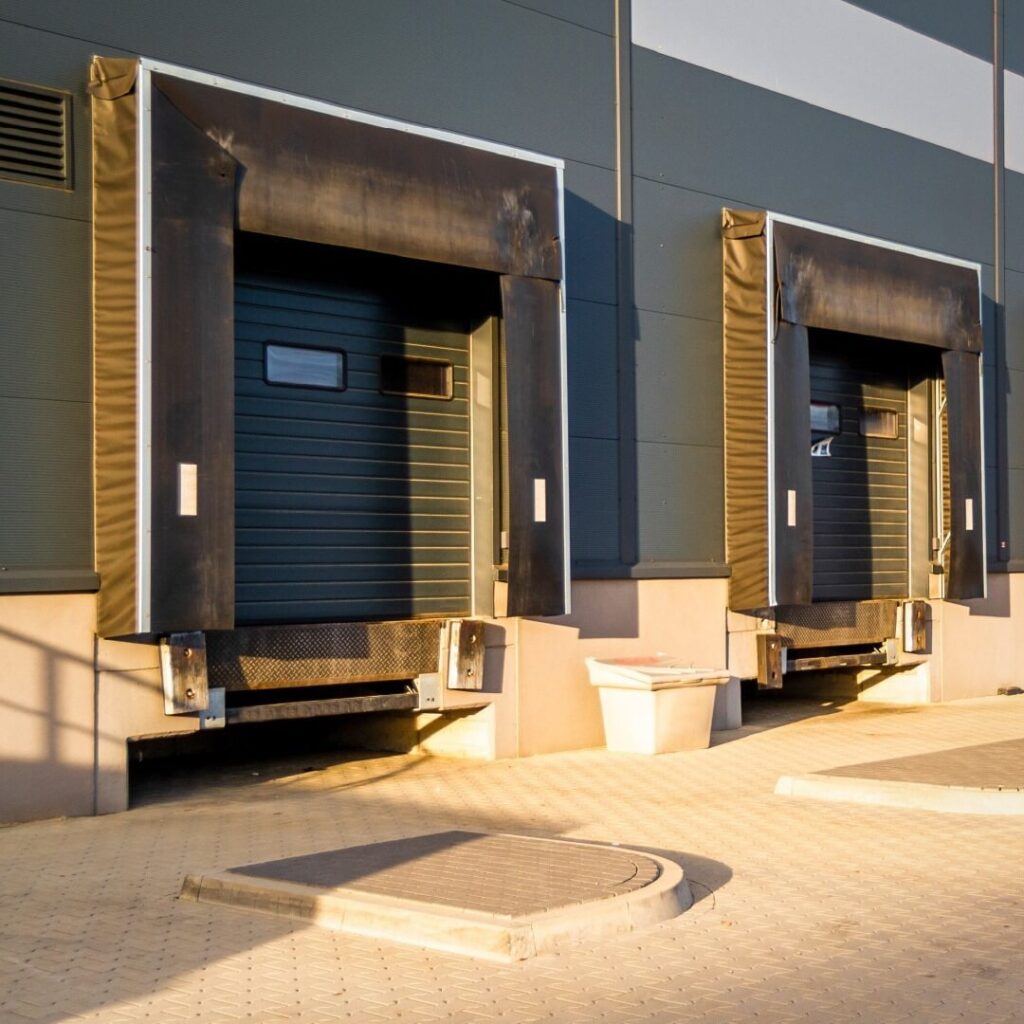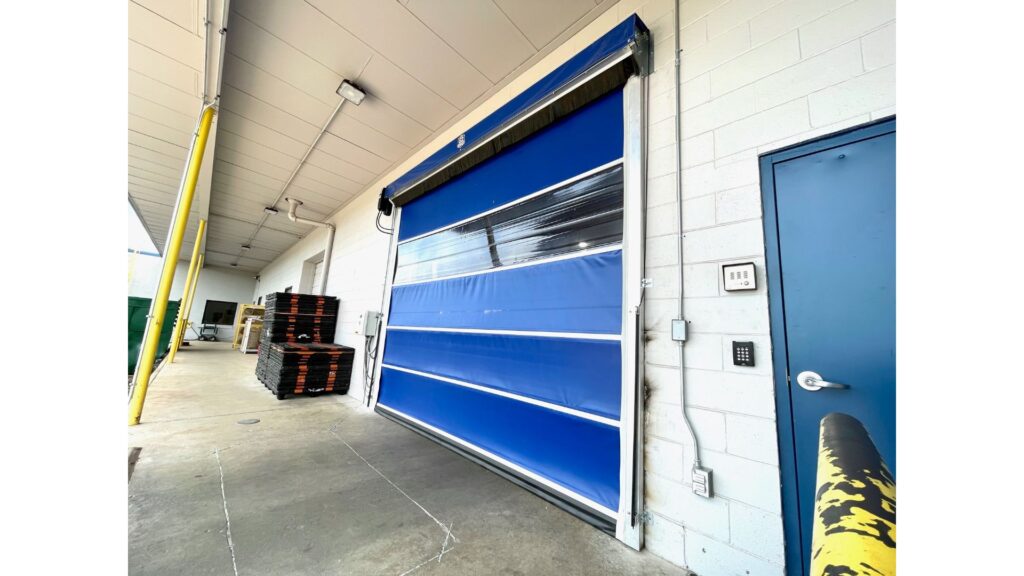You can find commercial fire doors in nearly any commercial building, especially in spaces where many customers, employees, and visitors may be present at any time. They are also used in residential spaces with numerous units, like apartment complexes. Commercial fire doors play an important role in emergency procedures and fire safety, which is why they are required in most building codes and regulations.
In this post, we’ll explain what a fire door is, the components they are made up of, and how they work to manage emergency fire situations. We’ll also look at a brief overview of where commercial fire doors are required in buildings, and answer some common questions about fire doors.
What is a Fire Door?
Fire doors are metal or wood commercial-grade doors that are designed to withstand extreme heat, manage emergency traffic flow, and prevent the spread of smoke and fire in a building. They are hollow metal doors that have an automatic closing device and latch to keep them in place.
Fire doors can be used for normal passage through a building, but they usually need to remain unlocked from the inside. This keeps them ready for emergency protocols at any moment. They are held to specific safety standards based on their location and the rules and regulations of the building itself.
What Are the Components of a Commercial Fire Door?
Fire doors are made up of several important pieces that contribute to the safety and functions of the door. Here are the basics of those components:
- The Door Itself: Also known as the door leaf, this is a hollow metal part of the door that swings open and closed. This part is made to be heat, fire, and smoke resistant.
- The Door Frame: The frame supports the door itself and it is also designed to withstand extreme heat and prevent the spread of fire.
- Various Types of Seals: Different fire doors will have different seals, but there are a few types available. Intumescent seals react to heat and expand to seal off gaps in the door. Smoke seals prevent the spread of smoke to maintain visibility and air quality during a fire for safer evacuation.
- Hardware: Fire doors have a lot of various hardware components for locks, latches, handles, hinges, and closers. These components are essential for ensuring seamless traffic, protecting areas from spreading fire, and keeping evacuations safe.
- Fire-Rated Glass: Some fire doors require better visibility. In these cases, they may include a fire-rated glass pane so that those in the building can see what is on the other side of the door whether there is an emergency or not.
- Compliance and Certification Labeling: Proper fire doors and hardware will be labeled with their materials and fire rating to ensure compliance.
- Thresholds: Fire-rated thresholds are used on some fire doors to improve the seal on the bottom of the door in the event of a fire.
How do Fire Doors Work?
Fire doors typically close automatically during a fire via a magnetic mechanism that releases the door and allows it to swing closed. When these doors close, they provide a barrier between the flames and other parts of the building.
These interior doors do not prevent fires themselves, but they do help manage fires and evacuations. By slowing the spread of smoke and fire, they can help provide a clear path for evacuation. They can also keep fires from spreading rapidly, avoid extensive property damage, and overall keep buildings safer during emergencies.
Where Are Commercial Fire Doors Located in Buildings?
Specific locations in buildings need fire doors to help keep the building as safe as possible. Here are some of those locations and why they need them.
- Hallways: Certain types of hallways that separate sections of a building or maintain heavy foot traffic need fire doors. Fire doors help contain the spread of fire in open areas like these.
- Entrances and Atriums: Lobbies, entrances, and atriums may have fire doors in some cases to protect the exterior of the building, contain fire and smoke spread, and manage evacuation routes.
- Garages: Garage spaces tend to have many electrical and flammable materials in them at any given time. Fire doors prevent fires in garages that may emit toxic fumes from spreading throughout a building.
- Hazardous Areas: In hospitals, laboratories, and other similar spaces, fire doors are essential for protecting hazardous materials. When exposed to fires and spreading when they burn, these materials can cause larger issues and damage.
- Stairwells: Because stairwells are large, vertical spaces, they can accumulate smoke quickly and spread to floors above the fire. Fire doors prevent this, sealing smoke into the areas of the fire and preventing it from spreading. This also helps keep stairwells clear for evacuation.
Fire Door Frequently Asked Questions
With fire doors, business owners often have questions about various aspects of their installation, function, longevity, cost, and more. Here are some of those questions and answers.
How Long Do Fire Doors Last?
Usually, fire doors are guaranteed to last a certain amount of time based on manufacturer information and warranties. Different building regulations may also dictate how often they must be inspected and replaced. In terms of fire protection time, fire doors are rated for different durabilities in different increments. Generally, fire doors are rated for 20 minutes, 45 minutes, 60 minutes, and 90 minutes. Their protection time and overall quality increase alongside price. The rating needed depends on building size, codes, and safety requirements for businesses.
How Often Do Commercial Fire Doors Need to Be Inspected?
Fire doors should be inspected once a year by a representative from your local fire department.
Should Fire Doors Be Locked?
No, fire doors should remain unblocked and unlocked at all times. Locking the doors, blocking their path, or forcing them to shut can violate safety codes. This may also create a safety hazard during a fire evacuation.
Can Glass or Wood Be Fire-Rated?
In some cases, yes, but these materials tend to be more expensive than the traditional hollow metal fire door. So long as the door is designed to be fire-resistant and prevent the spread of smoke, it can likely be fire-rated.
Can a Normal Door Be Converted to a Fire Door?
Not typically, no. Fire doors are designed to be fire-resistant. A normal hollow metal door, for example, is not manufactured with fire resistance in mind. This means they may not be able to be converted into a fire door.
Commercial Fire Doors: Wrapping Up
Fire doors are an essential part of any building, and they play a major role in the safety measures of emergency fire situations. Between their ability to keep exit routes clear, prevent the spread of smoke and fire, and minimize damage caused by fires, they are a critical component in commercial buildings. When inspected yearly and maintained, they play a major role in keeping everyone in your building safe!
If you need fire doors installed in your building, whether it’s just a few doors or dozens, call Commercial Door in Oklahoma for help! We’ll provide you with a free estimate on any commercial door project. Our team is ready to help in Norman, Oklahoma City, Tulsa, and surrounding areas for all your commercial door needs. Give us a call today, reach out on our contact page, and check out our services and blog for more information on what Commercial Door in Oklahoma can do for you and your business!





